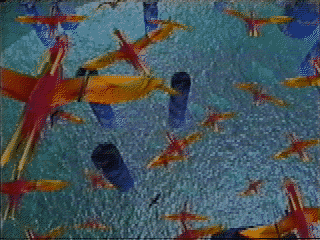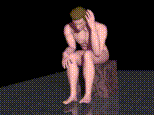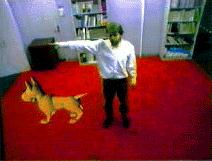 Artificial Plants (Przemyslaw Prusinkiewicz):
Artificial Plants (Przemyslaw Prusinkiewicz):This segment of the course will show how to use formalisms inspired by biological development processes to grow highly complex and realistic graphics models of plants. We will review Lindenmayer systems, introduced as a theoretical framework for studying the development of simple multicellular organisms and subsequently applied to the study of higher plants. Geometric and stochastic plant models expressed using L-systems have been extended in a manner suitable for simulating the interaction between a developing plant and its environment, including light, nutrients, and mechanical obstacles. We will also explain how to model the response of plants to pruning, which yields realistic synthetic images of sculptured plants found in topiary gardens.
 Artificial Evolution for Graphics and Animation
(Karl Sims):
Artificial Evolution for Graphics and Animation
(Karl Sims):This segment will show how artifical evolution allows virtual entities to be created without requiring detailed design and assembly. We will show how to evolve complex genetic codes that describe the computational procedures for automatically growing entities useful in graphics and animation. Fortunately, graphics practitioners are not required to understand these codes. Instead, they simply specify which results are more and less desirable as the entities evolve. This is a form of digital Darwinism. We will demonstrate the artificial evolution of several types of graphical entities, including virtual plants, textures, animations, 3D sculptures, and virtual creatures.
 Behavioral Animation and Evolution of Behavior (Craig
Reynolds):
Behavioral Animation and Evolution of Behavior (Craig
Reynolds):This segment will describe the design of autonomous behavioral actors. The animator can set up rules governing the interaction of autonomous agents in a virtual world. Once established, these rules can be used to automatically generate complex action for animation production or interactive multimedia. We will review a classic experiment, the flocking of ``boids,'' that convincingly bridged the gap between artificial life and computer animation. We will explain how this behavioral animation technique has been used to create special effects for feature films, such as the animation of flocks of bats in Batman Returns and herds of wildebeests in The Lion King. We will also explain how to automatically evolve behaviors that allow multiple animate agents to perform useful tasks such as navigation and game playing for multimedia applications.
 Artificial Animals (Demetri Terzopoulos):
Artificial Animals (Demetri Terzopoulos):This segment will show how to build highly realistic, autonomous models of animals for use in animation and virtual reality. We will present a bottom-up, holistic modeling approach in which we simulate the physics of the animal in its world, the animal's ability to exploit physics for locomotion, and its ability to link perception to action through adaptive behavior. As a concrete example, we will explain the details of a realistic virtual fish model that has (i) a 3D body with internal muscles and functional fins which locomotes in accordance with biomechanic and hydrodynamic principles, (ii) sensors, including eyes that can image the virtual environment, and (iii) a brain with motor, perception, behavior, and learning centers. We will outline a general approach to teaching artificial animals to perform complex locomotion tasks. Similar zoomimetic modeling principles are applicable to human animals. In particular, we will explore the highly automated construction of anatomically correct, functional models of people's heads from scanned data for facial animation.
 Artificial Humans in Virtual Worlds (Daniel Thalmann):
Artificial Humans in Virtual Worlds (Daniel Thalmann):This segment of the course comprises an in-depth investigation of techniques for modeling and animating the most complex living systems--human beings. In particular, we will explore the increasingly important role of perception in human modeling. Virtual humans are made aware of their virtual world by equipping them with visual, tactile, and auditory sensors. These sensors provide information to support human behavior such as visually directed locomotion, manipulation of objects, and response to sounds and utterances. We will demonstrate synthetic vision for visually-guided local and global navigation, game playing, walking on challenging terrain, etc. We will explore human sound rendering and auditory sensors that allow virtual actors to talk to one another and enable the animator to talk to them.
 Interactive Autonomous Agents (Bruce Blumberg):
Interactive Autonomous Agents (Bruce Blumberg):In the final segment of the course, we explore the design and implementation of systems that enable full-body interaction between human participants and graphical worlds inhabited by artificial life forms that people find engaging. Entertaining agents can be modeled as autonomous, behaving entities. These agents have their own goals and can sense and interpret the actions of participants and respond to them in real time. We will explore immersive, nonintrusive interaction techniques requiring no goggles, data-gloves/suits, or tethers. The general approach will be illustrated with the ALIVE (Artificial Life Interactive Video Environment) system, which many participants have experienced at SIGGRAPH exhibitions.


 Jump To:
Jump To: